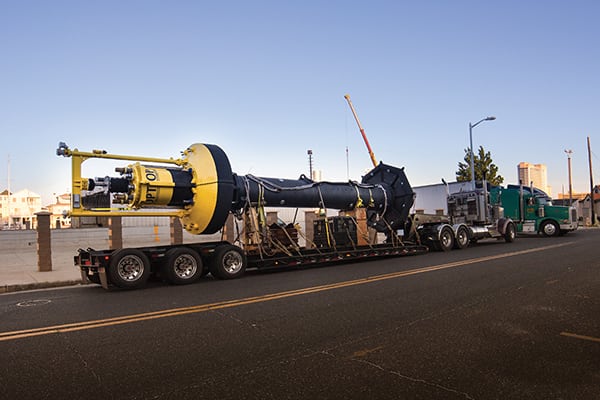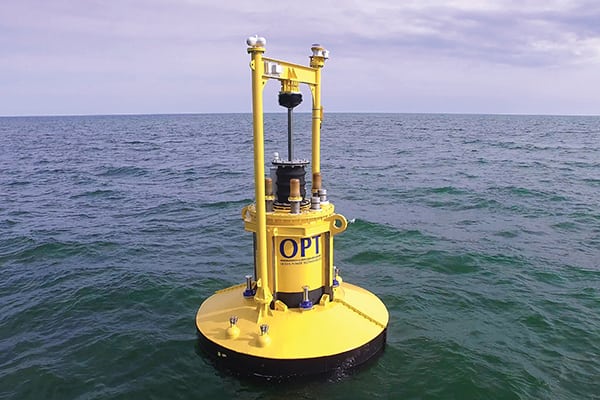Ocean Power Technologies Deploys Commercial PowerBuoy with Energy Storage
Ocean Power Technologies (OPT) deployed its first commercial PB3 PowerBuoy—a wave energy conversion system that incorporates energy storage—off the coast of New Jersey this July.
The Pennington, N.J.–based firm has been working to advance its PowerBuoy technology since the firm was founded in 1994. Development of the wave energy conversion technology for naval and civilian applications was catalyzed by small-business innovative research (SBIR) funding awards from the U.S. Navy. By 1997, following trials of a handful of PowerBuoy designs in the Navy’s wave tank facility and in the Atlantic Ocean, OPT demonstrated that the buoy could operate for more than 11 months at sea and endure harsh ocean conditions. Beginning in 2001, the company began developing more wave power systems at the Marine Corps base in Oahu, Hawaii. In 2005, it installed its first 40-kW buoy 1 mile off the coast of Oahu. That unit connected to the grid for the first time in 2010, following 4,400 hours of operation.
Deployment of the PB3 PowerBuoy (Figure 3) marks a major milestone for the company. The PB3 incorporates “multiple enhancements” over early prototypes, including a redesigned power take-off, a battery pack, a higher voltage power management and distribution system, and a new auto-ballasting system, which the company says allows for faster and less costly deployment.
Designed to be moored at a single point, the PB3 PowerBuoy produces 300 W of continuous power (depending on ocean conditions) and 7.2 kW at peak (1 hour per day). As it floats over ocean depths of between 20 meters (m) and 1,000 m (Figure 4), it constantly recharges itself by harvesting energy from waves and then converting that wave energy to power through a direct-drive generator. That power then charges an energy storage system, which delivers power to meet application and end-user needs. Its modular battery has a capacity of 44 kWh and is scalable to 150 kWh.
The PB3 technology was demonstrated for a Navy project to provide power to coastal security networks and “survived rigorous sea trials, including operation off the New Jersey coast through Hurricane Irene in 2011,” the company said.
The news follows OPT’s six-month lease agreement with Japanese firm Mitsui Engineering and Shipbuilding this June, a deal valued at $975,000 for PB3 PowerBuoys that are planned to be deployed off Kozy Island in Japan following a planned stage gate review. OPT will also provide engineering support, deployment planning and logistics, and ocean performance data collection and analysis. Mitsui and OPT are also reportedly collaborating to develop and test an advanced control algorithm to assess increased ocean wave energy capture and electric power generation for potential customers in Japan and other Asian nations.
Meanwhile, OPT said in a June 2016 statement that it will target a variety of markets over the next five years. Within the next two years, the PB3 PowerBuoy could snag a sizable share of the oceanographic and meteorological data market, it projected, but it will also seek customers in the oil and gas, defense and security, offshore wind, and communications sectors.
Over the next five years, the company also plans to substantially boost the technology’s maturation and commercialization. A second-generation PB3 model in the works could include a new, modular high-efficiency energy storage system. A future third-generation model would feature a more advanced and lighter hull design for improved power generation, the company said. That would be followed by the PB15-Gen1, which OPT envisions could generate more than 15 kW peak payload power. By 2020, it wants to commercialize the PBX model, which would use advanced hydro-dynamics, energy storage, and controls.
—Sonal Patel, associate editor

